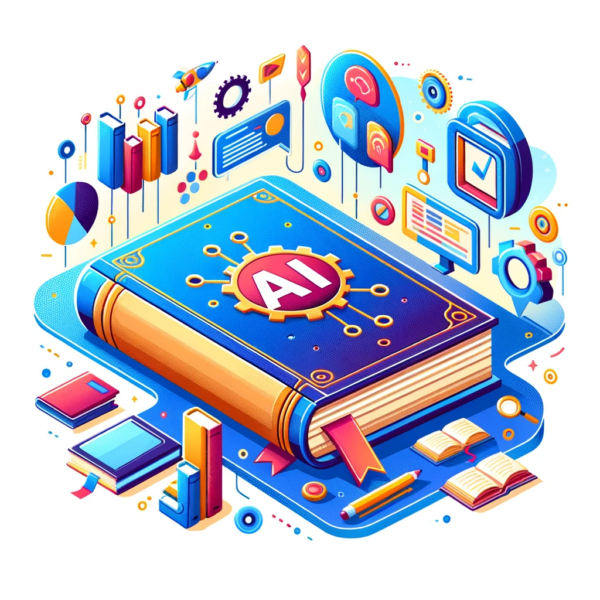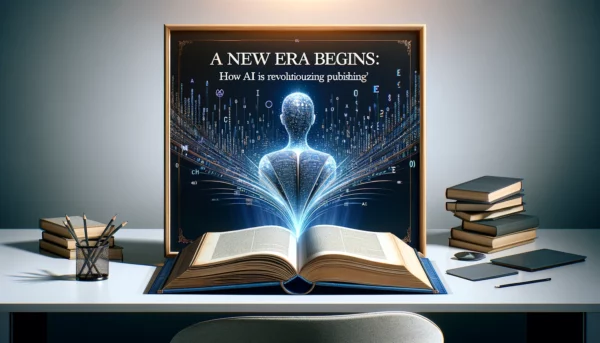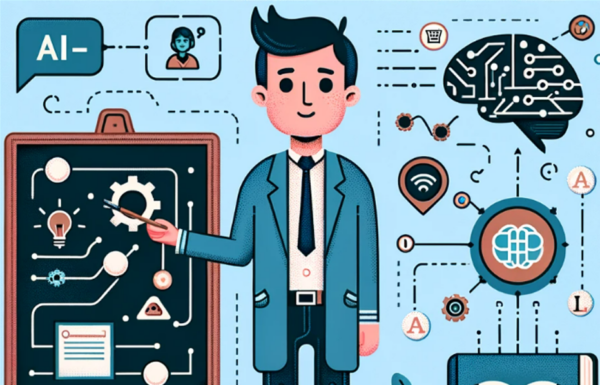The book publishing industry has undergone significant transformations over the past few decades. Initially dominated by traditional print, the sector has expanded to include ebooks and audiobooks, catering to a diverse range of consumer preferences.
Distribution channels have also evolved, moving from primarily physical bookstores to a mix of online retailers, digital platforms, and self-publishing avenues. Despite these advancements, the industry still faces challenges, such as predicting market trends, managing inventory efficiently, and personalizing marketing to diverse consumer bases.
AI and its Emerging Role in Various Industries, Including Publishing
From content creation and language translation to chatbots, artificial intelligence (AI) has emerged as a groundbreaking technology across various sectors, driving innovation and efficiency. In essence, AI involves the use of algorithms and software to simulate human intelligence, performing tasks such as learning, problem-solving, and decision-making. In industries like healthcare, finance, and retail, AI has revolutionized processes by providing data-driven insights, automating routine tasks, and enhancing customer experiences.
In the realm of publishing, AI is still a relatively new entrant but is rapidly gaining ground. From automated content creation to predictive analytics for consumer behavior, AI tools are beginning to reshape how publishers approach content creation, marketing, distribution, search engine data mine, and customer engagement.
Benefits of AI in Book Distribution for Publishers
The crux of this article lies in exploring how AI is revolutionizing book distribution for publishers. AI’s impact is multifaceted, offering unprecedented opportunities for publishers to understand their markets better, optimize their distribution strategies, and engage with readers more effectively.
By leveraging AI, publishers can not only streamline their distribution processes but also anticipate trends in the marketplace, tailor their offerings to specific reader segments, and ultimately, enhance their competitive edge in a rapidly evolving industry. The following sections will delve deeper into these aspects, illustrating the transformative potential of AI in book publishing and distribution.
Your Publishing Journey Awaits – Start NowA Brief History of Book Distribution Before AI: Challenges and Limitations
Before the advent of AI powered tools and modern technology, book distribution was a largely manual and intuition-driven process. Publishers primarily relied on historical sales data, retailer feedback, and market trends to make decisions about print runs, distribution networks, and marketing strategies. This approach, while functional, had several limitations:
- Inefficient Inventory Management: Without advanced data analysis tools, predicting the exact demand for new titles was challenging. This often resulted in either overproduction, leading to unsold stock and wastage, or underproduction, missing potential sales opportunities.
- Limited Market Insights: Understanding reader preferences and trends in the market was based on limited data sources like sales figures and surveys. This offered a reactive rather than proactive approach to market changes.
- Geographic Limitations: Distribution was heavily influenced by geographical constraints. Books popular in one region might not be readily available in another, limiting publishers’ reach.
- Dependence on Retail Channels: Publishers had to rely on bookstores and other retail outlets for distribution, which often meant less control over how and where their books were sold.
The Evolution of Technology in the Publishing Industry
The introduction of technology in the publishing industry marked a significant shift in how books were distributed:
- Digital Publishing: The rise of e-books and online publications expanded the market reach. It allowed for quicker distribution, lower production costs, and the ability to easily update content.
- Online Retail and E-commerce: Platforms like Amazon transformed book distribution by providing a global marketplace, making books accessible to a wider audience.
- Print-on-Demand: This technology allowed for printing books as per demand, reducing the risks of overproduction and unsold inventory.
- Data Analytics: Early forms of data analytics provided better insights into consumer behavior and trends, albeit not as sophisticated as AI-driven analytics.
- Social Media and Digital Marketing: These tools gave publishers direct access to their readers, allowing for targeted marketing and direct reader feedback.
Each of these technological advancements set the stage for the integration of AI into book distribution, addressing many of the historical challenges and opening up new opportunities for efficiency, market insight, and reader engagement.

Explanation of AI and Its Basic Principles
Artificial Intelligence (AI), at its core, is about creating machines that can perform tasks that typically require human intelligence. This involves the development of algorithms that enable computers to learn from data, make decisions, and solve problems. AI operates on the principles of learning from experience, identifying patterns within vast datasets, and making decisions based on the data it processes. In the context of book distribution, AI acts as a powerful tool for analyzing trends, consumer preferences, and operational efficiencies.
Natural Language Processing and Other Types of AI Technologies Relevant to Book Distribution
Several types of AI technologies are particularly relevant in the field of book distribution. Machine learning, a subset of AI, involves the use of algorithms that enable systems to learn and improve from experience without being explicitly programmed.
In book distribution, machine learning can be used for predictive analytics, such as forecasting which genres or titles are likely to be popular, thereby informing print runs and marketing strategies.
Natural Language Processing (NLP), another crucial aspect of AI, involves the ability of computers to understand, interpret, and respond to human language in a useful way. In the context of book distribution, natural language processing can be utilized for tasks like analyzing reader reviews and feedback, parsing through large volumes of textual data to glean insights into reader preferences and trends.
Other AI technologies like data mining and pattern recognition play a significant role in understanding consumer behavior and optimizing distribution networks. Data mining involves extracting valuable information from large datasets, which can help publishers identify hidden patterns and correlations that would be impossible to discern manually.
Pattern recognition allows systems to automatically recognize and categorize data, which is essential in segmenting audiences and personalizing marketing efforts.
Collectively, these AI technologies provide publishers with powerful tools to revolutionize the way books are distributed, moving from a traditional, intuition-based approach to a data-driven, efficient model. This shift not only improves operational efficiency but also enhances the ability to meet the dynamic demands of the market.
Your Publishing Journey Awaits – Start NowMajor Benefits of Artificial Intelligence in Book Distribution
One of the most significant benefits is its ability to use predictive analytics for understanding and forecasting trends in the market.
AI algorithms can analyze vast amounts of data, including past sales, current market conditions, and reader interests, to predict future trends. This predictive capability enables publishers to make more informed decisions about everything from print runs to marketing strategies.
By leveraging AI, publishers can anticipate which genres, authors, or themes are likely to resonate with readers in the near future. This foresight is particularly valuable in an industry where trends can shift rapidly and unpredictably.
For example, AI can detect emerging trends in reader interests by analyzing online conversations, search queries, and social media activity, providing publishers with a real-time pulse on the market.
How does AI work in action?
A notable example of AI in action is seen in the case of a major publishing house that used machine learning algorithms to analyze reader data from various sources. By doing so, they were able to identify a rising interest in a specific genre that was not previously mainstream.
This insight allowed them to invest confidently in new titles within that genre, resulting in several bestsellers.
Another instance involves a publisher who used AI to track and analyze online book reviews and ratings. The AI system was able to identify patterns in reader feedback that were not immediately obvious to human analysts.
This led to a better understanding of reader interests and helped shape the marketing strategy for new book launches, resulting in higher user engagement, and sales.
These case studies demonstrate how AI’s predictive analytics can provide publishers with a competitive edge, allowing them to stay ahead of market trends and better cater to the evolving preferences of their readers.
By embracing AI, publishers can transform their approach to book distribution, making it more proactive, data-driven, and attuned to the dynamic nature of reader interests.
Content creation
AI is also making a significant impact in the area of content creation within the publishing industry. The insights gained from AI-driven data analysis are not just limited to operational aspects but are increasingly influencing the content that publishers choose to develop and promote.
The case of the major publishing house that identified a rising interest in a particular genre through machine learning algorithms is a prime example of AI’s role in content creation. This data-driven approach allowed the publisher to tap into emerging reader interests, leading to the development and successful launch of titles in a previously underrepresented genre. Such successes underscore AI’s potential in guiding publishers toward content that resonates with current market demands and reader preferences.
Similarly, the publisher who utilized AI to analyze online book reviews and ratings exemplifies how AI can aid in content refinement and marketing. The insights gathered from AI analysis of reader feedback helped shape not only content and marketing strategies but also informed the publisher about the types of existing content that were receiving more favorable responses. This feedback loop is invaluable in an industry where reader engagement is key to success.
These instances demonstrate AI’s growing influence on the creative aspects of publishing. By providing publishers with deeper insights into reader interests and market dynamics, AI is enabling them to make more informed decisions about what content to create and relevant content that should be promoted. This shift towards a more data-driven approach in content creation represents a significant evolution in the publishing industry, one that aligns closely with changing reader habits and market trends.
In conclusion, AI’s integration into the publishing sector extends beyond distribution and inventory management, deeply influencing content creation and marketing strategies. As AI technology continues to advance, its role in shaping the future of publishing content is expected to grow, offering publishers new opportunities to connect with their audience and succeed in a competitive marketplace.
Improved Inventory Management
AI significantly enhances inventory management in book distribution. By analyzing sales data, market trends, and other relevant indicators, AI algorithms can accurately predict the demand for various titles.
This predictive capability allows publishers to optimize stock levels, ensuring that the right number of copies are printed and distributed. This optimization reduces the risks of overproduction and stockpiling, leading to a more efficient use of resources.
Real-world applications have shown remarkable outcomes. For instance, a publisher using AI-driven analytics reported a substantial reduction in unsold inventory, as the system was able to provide more accurate print run predictions based on real-time market data. This not only minimized waste but also resulted in significant cost savings.
Enhanced Customer Experience
AI also plays a vital role in enhancing the customer experience. By leveraging AI-powered recommendation engines, publishers can offer personalized book suggestions to readers. These recommendations are based on individual reading habits, reading history, preferences, and purchasing, making them highly relevant and engaging.
The impact on customer satisfaction and loyalty is profound. Readers who receive tailored recommendations are more likely to discover books that align with their interests, leading to a more satisfying reading experience.
This content personalization fosters a deeper connection between readers and publishers, potentially increasing customer loyalty and repeat purchases.
Cost Reduction and Efficiency
AI contributes to cost reduction and increased efficiency in book distribution. Streamlining distribution processes through AI not only makes them more efficient but also reduces operational costs.
AI systems can automate various aspects of the distribution process, from inventory management to order processing, minimizing the need for manual intervention and reducing the likelihood of human error.
One notable outcome of implementing AI in distribution processes is the significant reduction in operational costs. Publishers have reported lower storage and logistics expenses due to more efficient stock management.
Additionally, the automation of routine tasks has led to labor cost savings and allowed staff to focus on more strategic aspects of the business.
In summary, the integration of AI in book distribution offers a multitude of benefits, including improved inventory management, enhanced customer experience, and increased operational efficiency.
These advancements not only lead to cost savings but also provide a more responsive and personalized service to readers, positioning publishers favorably in a competitive market.
Your Publishing Journey Awaits – Start NowChallenges and Considerations
Technical and Logistical Challenges in Adopting AI
Adopting AI in book distribution is not without its technical and logistical challenges. For many publishers, especially smaller ones, the initial barrier is the technical expertise required to implement AI systems. Understanding and integrating complex AI algorithms demands a certain level of proficiency in data science and machine learning, which might necessitate hiring new talent or upskilling existing staff.
Additionally, integrating AI into existing distribution networks can pose logistical challenges. Aligning AI systems with legacy systems, ensuring data compatibility, and training staff to work with new tools can be time-consuming and resource-intensive. There’s also the challenge of continuous data collection and analysis, which is essential for AI systems to function effectively but can be demanding in terms of infrastructure and data management.
Ethical Considerations and Impact on Employment
The introduction of AI in book distribution also raises ethical considerations, particularly regarding its impact on employment. Automation of certain tasks could lead to job displacement, which is a significant concern for the workforce. It’s important for publishers to address these concerns thoughtfully, potentially through measures like retraining programs, redeployment into new roles, or gradual integration of AI to allow time for adaptation.
Moreover, there’s the issue of data privacy and security. As AI systems require access to vast amounts of data, ensuring this data is handled ethically and securely is paramount. Publishers must navigate data protection regulations and ethical considerations around the use of personal data.
Balancing Technology and Human Judgment
Another key consideration is balancing technology with human judgment. While AI can process and analyze data at a scale unattainable by humans, it lacks the nuanced understanding and creative judgment that human professionals bring. AI should be viewed as a tool that augments human decision-making, not one that replaces it.
This balance is particularly important in an industry like the publishing world, where understanding cultural nuances, reader sentiment, and creative content is crucial. Publishers need to ensure that AI-driven decisions are tempered with human insight, especially in areas like content creation, selection, marketing strategies, and understanding reader feedback.
In summary, while AI presents significant opportunities for improving book distribution, its adoption comes with a range of challenges and considerations. Addressing these effectively requires a strategic approach, careful planning, and a commitment to balancing technological innovation with ethical and human-centric practices.
Future of AI in Book Distribution
Emerging Trends and Future Developments
The future of AI in book distribution is poised to be influenced by several emerging trends and technological advancements. One significant trend is the increasing use of AI for more sophisticated predictive analytics. Future AI systems are expected to analyze not just sales data but also a broader array of indicators such as global news events, social media trends, and even weather patterns, to predict book demand more accurately.
Another trend is the integration of AI with other cutting-edge technologies like blockchain for secure and transparent supply chain management, and augmented reality (AR) for interactive marketing and reader engagement. There’s also the growing potential of AI in personalized content creation, where AI tools could help in tailoring books or articles to suit individual reader interests.
Predictions and Expert Opinions
Experts predict that AI will continue to significantly influence the book distribution landscape. One key area is the enhancement of customer experience. AI is enabling publishers to become more adept at understanding and predicting reader interests, leading to more personalized and engaging reading recommendations.
There’s also a strong belief that AI will make distribution networks more efficient and responsive. With advancements in AI, the logistics of book distribution, including inventory management, shipping, and handling returns, could see further improvements, reducing waste and optimizing resource use.
Another prediction is that AI will play a critical role in identifying and nurturing new writing talent. By analyzing market trends and reader preferences, AI could help publishers spot emerging authors and genres more swiftly, potentially revolutionizing the scouting process.
However, with these advancements, the need for ethical considerations and maintaining a human-centric approach becomes more crucial. Experts emphasize the importance of balancing AI capabilities with human judgment, especially in a field as subjective and culturally nuanced as publishing.
In conclusion, the future of AI in book distribution is bright and full of potential. As the technology evolves, it is set to bring about more profound changes in the way books are distributed and consumed. The industry is likely to witness enhanced efficiency, more personalized reader experiences, and innovative content delivery methods, all driven by the transformative power of AI.
The integration of Artificial Intelligence (AI) into book distribution has ushered in a transformative era for publishers. This article has explored the myriad ways in which AI is reshaping the industry, highlighting its significant benefits and potential for future development.
AI’s ability to conduct predictive analytics has emerged as a game-changer, allowing publishers to anticipate market trends and reader interests with unprecedented accuracy. This foresight aids in making informed decisions about print runs, reducing the risks of overproduction, and ensuring that books reach the right audience at the right time. Moreover, AI-driven inventory management has proven to be a boon, optimizing stock levels and minimizing waste, thereby enhancing operational efficiency and sustainability.
The enhanced customer experience facilitated by AI, through personalized recommendations and targeted marketing, has not only boosted sales but also fostered deeper engagement and loyalty among readers. These advancements demonstrate the critical role of AI in aligning publishing strategies with evolving consumer behaviors.
The transformative impact of AI on the publishing industry cannot be overstated. It has not only streamlined distribution processes but also opened up new avenues for growth and innovation. By harnessing the power of AI, publishers are better equipped to navigate the dynamic market landscape, respond to changing reader interests, and stay ahead in a competitive industry.
As we look to the future, the call to action for the publishing industry is clear: embracing AI technologies is no longer an option but a necessity. Publishers must continue to invest in and adapt to AI advancements to remain relevant and thrive.
This requires a commitment to ongoing learning, adaptation, and a willingness to innovate. By doing so, the industry can unlock the full potential of AI, ensuring a vibrant and dynamic future for book publishing and distribution.








